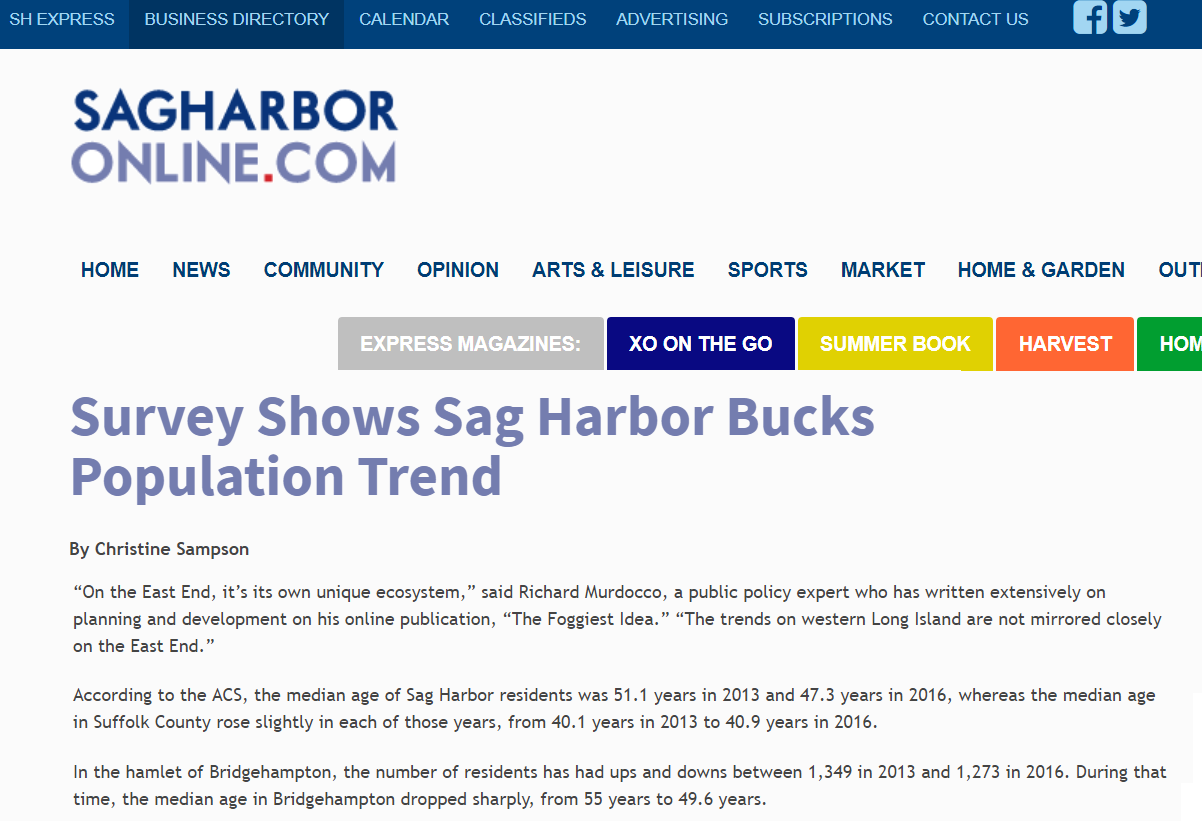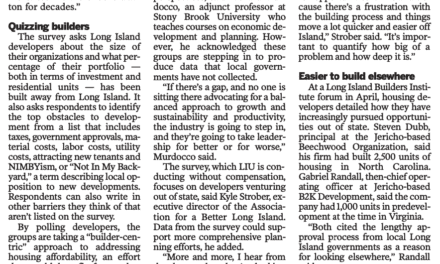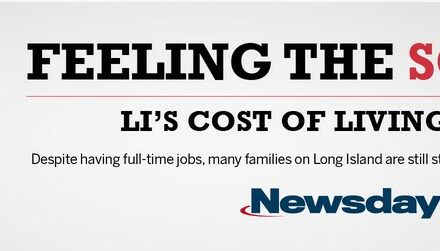The following article originally written by Christine Sampson, and was published in the Sag Harbor Express in January 10th, 2018. The Foggiest Idea is quoted throughout the piece. You can read the original version here.
By Christine Sampson
As Suffolk County continued a four-year trend of seeing its population shrink and its residents’ median age rise slightly, Sag Harbor’s demographic trends moved in the opposite direction with slow population growth and a decline in median age, according to data released by the federal government in December.
The data, known as the American Community Survey (ACS), presents information collected in 2016 on a wide variety of topics, from the total number of residents to their ages, races, housing situations and more. ACS data is collected and released in between full United States Census Bureau counts. The next full Census is set for 2020.
The incorporated village of Sag Harbor was home to 1,943 people in 2013, and by 2016 the village had 2,132 residents, a 9.7 percent increase over four years. In the same time, Suffolk County’s population declined .5 percent, or about 8,200 people, down to approximately 1.492 million people. Nassau and Suffolk counties together were home to 2,854,083 people in 2016.
“On the East End, it’s its own unique ecosystem,” said Richard Murdocco, a public policy expert who has written extensively on planning and development on his online publication, “The Foggiest Idea.” “The trends on western Long Island are not mirrored closely on the East End.”
According to the ACS, the median age of Sag Harbor residents was 51.1 years in 2013 and 47.3 years in 2016, whereas the median age in Suffolk County rose slightly in each of those years, from 40.1 years in 2013 to 40.9 years in 2016.
In the hamlet of Bridgehampton, the number of residents has had ups and downs between 1,349 in 2013 and 1,273 in 2016. During that time, the median age in Bridgehampton dropped sharply, from 55 years to 49.6 years.
Factors such as the cost of housing and availability of jobs influence these numbers, Mr. Murdocco said.
But when a community is growing in the face of those impacts, he said, “What is the quality of life like? Is it the school district? What are the policy makers doing right? Why is it more desirable?”
Asked what Sag Harbor is “doing right,” Mayor Sandra Schroeder simply said, “Just look at what we have here.”
“All the people who volunteer to do things. We have a wonderful school system,” she said. “Look at what happens when you have a disaster — everyone shows up, they run to see what they can do. It’s a good place to be.”
Ms. Schroeder corroborated Sag Harbor’s slow population growth as seen in the ACS, saying many people who bought summer homes are now starting to live here full-time, many as retirees. She said it’s showing in increased voter registration numbers, too.
ACS data also breaks down information such as age groups, racial diversity and housing characteristics.
In Sag Harbor, youths between the ages of 5 and 19 accounted for 8.9 percent of the population in 2013, a figure that rose to 11.4 percent in 2016. In Bridgehampton, youths between the ages of 5 and 19 made up 12.8 percent of the population in 2013 and 14.5 percent of the population in 2016.
“Population trends as they pertain to age and certain demographics are cyclical,” Mr. Murdocco said. “You can’t have people leave if they were never born. Long Island is getting older. It is getting harder for entry-level buyers to come in. That being said, the single-family market is booming and it is being driven by millennials who want what Long Island has to offer. They want the white picket fence and the good schools.”
On the opposite side of the spectrum, people age 65 and older accounted for 24.9 percent of Sag Harbor’s population in 2013 and 23.9 percent of the population in 2016. In Bridgehampton, people age 65 and older represented 25.1 percent of the population in 2013 and 29.2 percent of the population in 2016. Another significant age group in Bridgehampton was the 40-to-49 year old demographic, which made up 16.6 percent of the population in 2013 and 21.3 percent in 2016.
In Sag Harbor, about 67 percent of renters are paying 35 percent or more of their income on housing, up from about 42 percent of renters paying that much in 2013. Experts say people should pay no more than a quarter of their income on housing.
Sag Harbor has also become a bit more diverse. While Caucasian remains the majority race, it made up 76.9 percent of the population in 2013 and 68.9 percent in 2016. Among the racial groups growing in numbers is Latinos, which made up 10 percent of the population in 2013 and 16.8 percent in 2016.
Margins of error exist in the data, and in some areas fluctuate widely, suggesting that population demographics may not be fully understood on the East End, Mr. Murdocco said.
“The ACS isn’t the Census — it isn’t as diligent as the Census,” he said, calling the ACS “snapshots in time.” “The Census is the gold standard, but even that has been challenged by lack of funding and administrative support in the last several years, so even those studies in the region are going to be impacted as well.”














I truly do not see a dramatic change in the demographics. I would like to read about the school situation in the area, as well as the direction the electorate appears to be taking. The cost of living definitely will continue to impact on society in the referenced section of Long Island. Now is the time to explore all options and then move in a positive direction designed to attract, maintain, and support a mixed population of socially aware and devoted individuals.